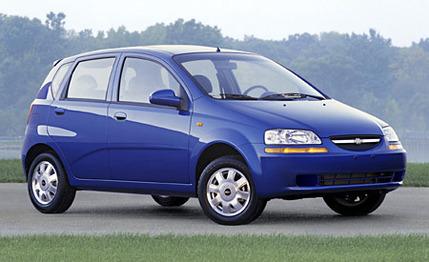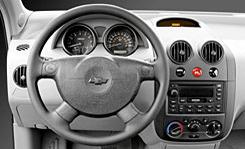
 Road Test
Road Test
As lineage goes, the Chevrolet Aveo's might have a slight pedigree advantage over that of Anna Nicole Smith's son.
This inexpensive car from Chevy is the latest in a particularly motley branch of the automotive family tree--an American-branded car made in Korea. Think Ford's Kia-built Aspire and Festiva. Think Pontiac's desecration of that once-revered name, the LeMans, built by Daewoo. These are not cars in the Gearhead Hall o' Fame.
I once lived in a flat beneath an erotic dancer who drove a Festiva with a bumper sticker that read, "You've been a bad boy, go to my room!" Other than that, the Festiva was not, you know, a stimulating car.
Ah, but we were talking about the new Aveo--which you may pronounce ah- vay-oh or av-ee-oh, your pick. You could also call it a Kalos, since that is the name of the Daewoo model on which it is based. Well, actually more than just "based"--more like "basically identical to." This refugee Chevy, which is nonetheless featured in the division's much-ballyhooed "American Revolution" advertising campaign, is built in Bupyong, South Korea, which is not in Wisconsin but is fun to say aloud. Over the last year, GM has also quietly introduced three other Daewoos under the Suzuki badge. The General has a controlling interest in both companies.
Forgive us, then, if we were planning to take this car lightly. When it was dropped off in our parking lot, we . . . well, we didn't really notice. Chevrolet says the Aveo was styled at Italdesign-Giugiaro in Moncalieri, Italy. And we have no reason to believe the company is lying. Chevy describes the five-door Aveo as having a "particularly striking design." This is what's known as overstatement. Truth is, the Aveo comes from the same postmodern-dork design school as the Toyota Echo and Suzuki Aerio--both competitors of the Aveo. Tall, upright, and narrow, all these cars violate a certain innate human sense of proportion. Also, the tall, bluff sides of the Aveo make the respectably sized wheels (14-inchers) look like casters under a toolbox. Nothing screams "econobox" quite like really small tires. At 58.9 inches high, the Aveo five-door pokes between two and three inches higher into the atmosphere than a Dodge Neon, Ford Focus, or Honda Civic, but it rides on a wheelbase between 5.4 and 7.4 inches shorter and is an inch or two narrower than those sedans.


There is, nonetheless, beauty inside the Aveo. Pop open one of its flyweight doors, and you'll find 50 cubic feet of interior space in front and 41 in the rear, despite its modest exterior dimensions. That's about the same amount of interior room as in most of its competitors. Be aware, however, that some of that generous number of cubes is high up around the driver's head because of the tall roof. But the Aveo, at least the five-door we tested, is a well-packaged device. The rear bench seat sits far rearward in the car--placing rear-seat passenger heads near the backlight. This arrangement sacrifices cargo room--there's a puny seven cubic feet of storage behind the rear seats. But unless you need to take five people and their baggage, the Aveo will do just fine. In the current vogue, the seats are all mounted high in the body. You feel more like you're sitting on a kitchen chair than in a bucket seat. Also, it makes the driver look and feel like a geek.
Being that most practical of small vehicles, a hatchback, you can also convert that rear-seat space into cargo room. Fold the 60/40-split seatbacks, pivot the bench forward, and secure it with tethers to the front headrests, and you get a more-than-credible 42 cubic feet of cargo room. The whole tether thing is a bit cheesy-looking, but it works.
It was the interior that gave us the first inkling this might not be as bad a car as we'd expected. Our test car, a well-optioned LS, costs only $14,160, but the interior is finished in decent-looking, low-sheen plastics. The Aveo doesn't look any cheaper inside than do several more-expensive, U.S.-built GM models. Daewoo even tried--somewhat half-heartedly--to add a bit of funkiness to the interior design. The center stack is bordered by strips of dimpled black plastic. Kia likely would have just used one big swath of hard black plastic instead. The two center vents are shaped like tubes that protrude from the face of the dash instead of just simple grate-covered holes. Daewoo might be reaching for a sort-of Beetle/Mini style, but the splashes of style are subtle and inconsistent enough to make them look like little more than afterthoughts applied to an otherwise conventional interior.